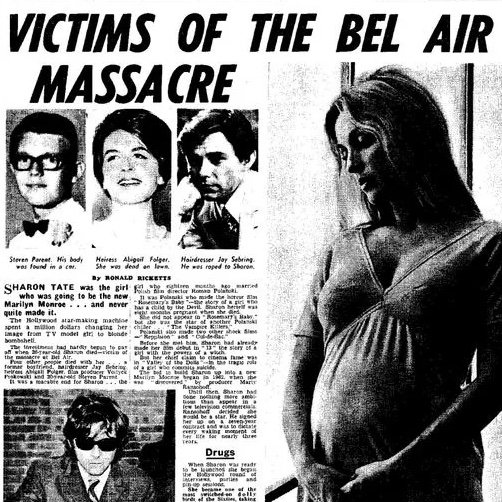Listen to this episode on Apple Podcasts.
After the murders, Manson moved his family to the depths of the California desert. There, even before they were finally apprehended by the law, their utopia started to fall apart. Hollywood was in the process of being changed by Dennis Hopper's Easy Rider, a film shot partially in the same desert where Manson was now hiding. The Family and their flight to Death Valley -- and the impossible dream of the 60s revolution in general -- was soon thereafter unwittingly reflected in Italian filmmaker Michelangelo Antonioni's attempt to make a Hollywood studio film, Zabriskie Point, starring Hopper's future wife.
Show Notes:
Special thanks to this week's special guests: Nate DiMeo reprised his role as Charles Manson, and we were lucky to have Max Linsky, of Longform.org and the Longform Podcast, playing Mel Lyman.
The base list of sources for this series can be found here. The second half of this episode, about Mel Lyman and Zabriskie Point, is indebted to a whole different set of sources:
The Lyman Family's Holy Siege of America by David Felton, Rolling Stone, December 23, 1971
The Sorry Life and Death of Mark Frechette by Dave O'Brian, Rolling Stone, November 6, 1975
Once-Notorious '60s Commune Evolves Into Respectability: After 19 Years the Lyman Family Prospers as Craftsmen and Farmers.LA Times, August 4, 1985
Return to Zabriskie Point: The Mark Frechette and Daria Halprin Story, by Sam Tweedle, Confessions of a Pop Culture Addict
See also: the "four obscene words" editorial in Avatar; and the trailer for Zabriskie Point.
This episode is titled after the Sonic Youth song "Death Valley '69," which, as Kim Gordon explains in her memoir Girl in a Band, was partially inspired by the Manson family. I included a few other Sonic Youth songs just for their vibe; Gordon tells stories about many of them in her book. I particularly like the story about how "Halloween" was inspired by Henry Rollins.
The final song in this episode before the end credits was composed and submitted by YMRT listener Blake Godfrey. If you'd like to submit your music for consideration for use in a future episode, the best way to do that is by sending Karina a link to your stuff on Soundcloud or whatever streaming thing you prefer.
Episode breakdown:
Intro: "Album Tag Song" by Dennis Wilson; "Modern Heavy Rock Guitar Top Line" royalty free loop
Woodstock: "Mellow Music Theme Instrumental" royalty free track
Spahn Ranch raided by Straight Satans and police: "Southern Rhythm Guitar" GarageBand loop
Shorty Shea's murder: "Psychedelic 6 Guitars Soundscape Mystery" royalty free track
Barker Ranch, Easy Rider connection: "Dark Melodic Metal Guitar Loop 1 Long" royalty free loop; "Death Valley '69" by Sonic Youth
Linda Kasabian leaves the Manson Family: "70s Acid Trip 2 Guitar Loop" royalty free loop
The Manson Family in the desert, preparing for Helter Skelter and searching for the Bottomless Pit; Juan Flynn; Danny DeCarlo's defection; Barbara Hoyt and Kitty Lutesinger want to leave; Barbara and Sherrie leave; Sherrie Doe's body is found: "Halloween" by Sonic Youth
Manson vs. Scientologist prospector Crockett; Juan Flynn's defection: "Stranger on a Train": by Sonic Youth
Hard times in the desert force Manson to beg from Gregg Jakobson; Charlie cracks the whip; the earth mover fire;: "Because Coda" by Sonic Youth
Rangers question Crockett about Manson Family; Crockett freaks out; Rangers find Tex Watson's Toyota: "Halloween" by Sonic Youth
Charlie tells Tex to shoot the Rangers; Tex defects; Kitty and Stephanie escape; the first raid on Barker Ranch; "Devastation and Revenge" by Kevin MacLeod
Charlie thinks he's escaped arrest; second raid on Barker Ranch; cops find Manson hiding in a cabinet; Charlie tries to talk his way out of arrest by invoking Helter Skelter; Kitty tells the police everything she knows; Susan talks to investigators about Gary Hinman; Susan spills to her jailhouse roommates; Virginia and Ronnie decide to snitch; Danny DeCarlo talks; LAPD announces they've cracked the Tate case: "Remembering Past Everything" by Pipe Choir
Zabriskie Point plot connections to the Manson Family: "Stormy Moods Orchestra" by Apache Tomcat
Zabriskie Point as doomed production; casting of Daria Halprin and Mark Frechette; Mel Lyman, the Fort Hill Community; Avatar Magazine and first amendment battles: "Railroad's Whiskey Co" by Jahzzar
Daria Halprin marries Dennis Hopper; Mark Frechette robs a bank; Frechette dies in prison; similarities between Lyman and Manson; future of Fort Hill; Manson's letter to Lyman"A Memory Starts" by Blake Godfrey
End Credits: "Pop Rock Guitar Rhythm Loop" royalty free loop
Outro: "Expressway To Yr Skull" by Sonic Youth



